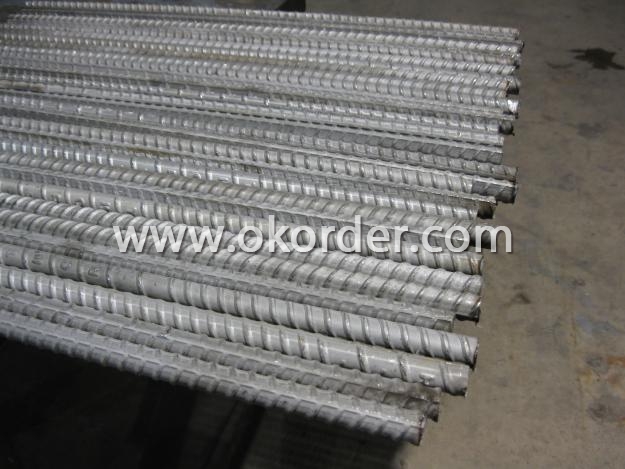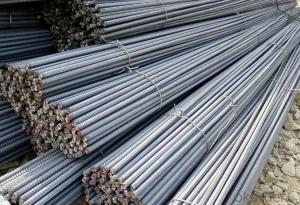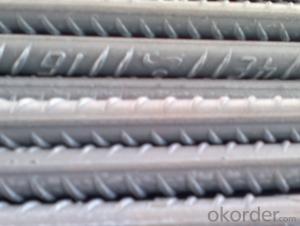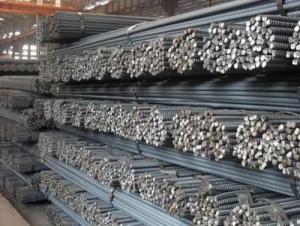Steel Rebar
- Loading Port:
- China Main Port
- Payment Terms:
- TT or L/C
- Min Order Qty:
- 50Tons m.t.
- Supply Capability:
- 1000 Tons Per Day m.t./month
OKorder Service Pledge
OKorder Financial Service
You Might Also Like
Specifications of Steel Rebar:
Standard | GB UK USA | HRB335 HRB400 HRB500 G460B, B500A, B500B,B500C GR40, GR60 | |
Diameter | 6mm,8mm,10mm,12mm,14mm,16mm,18mm,20mm, 22mm,25mm,28mm,32mm,36mm,40mm,50mm | ||
Length | 6M, 9M,12M or as required | ||
Price | Keep lower operating costs so as to offer competitive price for our clients | ||
Label | to be specified by customer, generally, each bundle has 1-2 labels | ||
Application | Building, construction | ||
Invoicing | Actual or Theoretical Weight Basis as buyer’s request. | ||
Type | Hot rolled steel rebar | ||
Brand name | DRAGON | ||
Theoretical weight and section area of each diameter as below for your information:
Diameter(mm) | Section area (mm²) | Mass(kg/m) | Weight of 12m (kg) | Pcs/ton |
6 | 28.27 | 0.222 | 2.664 | 375.38 |
8 | 50.27 | 0.395 | 4.74 | 210.97 |
10 | 78.54 | 0.617 | 7.404 | 135.06 |
12 | 113.1 | 0.888 | 10.656 | 93.84 |
14 | 153.9 | 1.21 | 14.52 | 68.87 |
16 | 201.1 | 1.58 | 18.96 | 52.74 |
18 | 254.5 | 2.00 | 24 | 41.67 |
20 | 314.2 | 2.47 | 29.64 | 33.74 |
22 | 380.1 | 2.98 | 35.76 | 27.96 |
25 | 490.9 | 3.85 | 46.2 | 21.65 |
28 | 615.8 | 4.83 | 57.96 | 17.25 |
32 | 804.2 | 6.31 | 75.72 | 13.21 |
36 | 1018 | 7.99 | 98.88 | 10.43 |
40 | 1257 | 9.87 | 118.44 | 8.44 |
50 | 1964 | 15.42 | 185.04 | 5.40 |
Steel Rebar in warehouse


Chemical Composition: (Please kindly find our chemistry of our material based on BS4449 as below for your information)
BS4449 G460B | Chemical Composition | ||||
C | Mn | Si | S | P | |
0.18 | 0.35 | 0.14 | 0.025 | 0.25 | |
Physical capability | |||||
Yield Strength(N/cm²) | Tensile Strength(N/cm²) | Elongation (%) | |||
625 | ≥460 | 18 | |||
Usage and Applications of Steel Rebar:
Deformed bar is widely used in buildings, bridges, roads and other engineering construction. Big to highways, railways, bridges, culverts, tunnels, public facilities such as flood control, dam, small to housing construction, beam, column, wall and the foundation of the plate, deformed bar is an integral structure material. With the development of world economy and the vigorous development of infrastructure construction, real estate, the demand for deformed bar will be larger and larger..
Packaging & Delivery of Steel Rebar:
Packaging Detail: products are packed in bundle and then shipped by container or bulk vessel, deformed bar is usually naked strapping delivery, when storing, please pay attention to moisture proof. The performance of rust will produce adverse effect.
Each bundle weight: 2-3MT, or as required
Payment terms: TT payment in advance or Irrevocable LC at sight.
Trade terms :FOB, CFR, CIF
Delivery Detail: within 45 days after received advanced payment or LC.
Note:
1. Our products are produced according to national standard (GB), if not, supply according to national standards (GB) or agreement as customer required.
2. Other Grade and Standard Deformed Steel Bar we can supply:
Grade: GR40/GR60, G460B/B500A/B500B/B500C,BST500S
Standard: ASTM, BS, DIN
The Minimum Order Quantity of these products is high, and need to be confirmed.
3. We can not only supply Deformed Steel Bar; if you need anything about building materials, please contact us for further information.
4. Please send us your detail specifications when inquire. We will reply to you as soon as possible. We sincerely hope we can establish a long stable business relationship.
- Q:Are steel rebars suitable for use in high-traffic areas like bridges?
- Yes, steel rebars are suitable for use in high-traffic areas like bridges. Steel rebars provide exceptional strength and durability, making them ideal for withstanding heavy loads and frequent use. Additionally, steel rebars offer excellent resistance to corrosion, ensuring the longevity and structural integrity of bridges in high-traffic areas.
- Q:Can steel rebars be used in both residential and commercial construction?
- Yes, steel rebars can be used in both residential and commercial construction. Steel rebars are commonly used as reinforcement in concrete structures to provide added strength and durability. They are suitable for a wide range of applications, including foundations, walls, columns, beams, and slabs, which are common elements in both residential and commercial construction. The use of steel rebars ensures that the concrete structures can withstand the loads and stresses imposed on them, making them suitable for various construction projects, regardless of their scale or purpose.
- Q:What is the impact of steel rebars on the overall sustainability of a building?
- The overall sustainability of a building is greatly influenced by steel rebars, which have various implications for the environment, economy, and society. Firstly, the use of steel rebars strengthens and prolongs the lifespan of a structure, reducing the need for repairs and renovations and minimizing resource consumption and waste. In terms of environmental impact, steel rebars can be recycled, decreasing the demand for new steel production and the carbon emissions associated with it. Recycling steel rebars also saves energy and reduces the extraction of raw materials like iron ore and coal. Additionally, steel rebars can be salvaged and repurposed in other construction projects, further extending their usefulness and reducing waste. From an economic perspective, incorporating steel rebars can result in cost savings in construction and maintenance. Steel is a versatile and strong material, allowing for lighter and more efficient designs, leading to reduced material and labor costs. Moreover, the recyclability and salvagability of steel rebars can provide economic benefits through resale or repurposing. Furthermore, steel rebars play a crucial role in ensuring the safety and structural integrity of buildings, particularly in areas prone to earthquakes or high winds. By reinforcing concrete, steel rebars enhance a building's resistance to external forces, reducing the risk of collapse or damage during natural disasters. This aspect of safety is vital for the well-being of occupants and the community as a whole. In conclusion, steel rebars have a positive impact on the overall sustainability of a building, contributing to durability, reducing environmental impacts through recycling and reuse, offering economic benefits, and enhancing structural safety. The incorporation of steel rebars in construction projects can significantly improve the long-term sustainability and resilience of buildings.
- Q:Can steel rebars be used in the construction of offshore platforms?
- Yes, steel rebars can be used in the construction of offshore platforms. Steel rebars offer high tensile strength and durability, making them suitable for withstanding the harsh marine environment and heavy loads associated with offshore platforms. Additionally, they can be easily fabricated and installed, making them a popular choice in offshore construction projects.
- Q:What are the common mistakes to avoid while using steel rebars?
- When using steel rebars, there are several common mistakes that should be avoided to ensure the structural integrity and safety of the construction project. Some of these mistakes include: 1. Insufficient cover: Failing to provide enough concrete cover over the rebars can lead to corrosion and reduced strength. It is important to follow the design specifications and ensure the required cover is maintained throughout the construction process. 2. Improper placement: Incorrectly placing the rebars can result in weak areas within the structure. It is crucial to follow the approved drawings and ensure proper spacing, alignment, and lap lengths are maintained. 3. Inadequate anchoring: Insufficient anchoring of the rebars can lead to inadequate load transfer and structural failure. It is essential to properly anchor the rebars by providing adequate hooks or bends at the ends and using appropriate tie wire or mechanical connectors. 4. Poor welding practices: If welding is required to connect rebars, it is essential to follow proper welding procedures and ensure high-quality welds. Inadequate or improper welding can weaken the rebars and compromise the structural strength. 5. Neglecting corrosion protection: Steel rebars are susceptible to corrosion, especially in humid or marine environments. Neglecting to provide proper corrosion protection, such as epoxy coating or corrosion inhibitors, can result in premature deterioration and reduced structural performance. 6. Overlapping rebars incorrectly: Overlapping rebars is necessary to ensure the transfer of forces between adjacent sections. However, overlapping them incorrectly by either insufficient length or improper alignment can compromise the structural integrity. 7. Lack of inspection and quality control: Failing to conduct regular inspections and quality control checks during the construction process can lead to unnoticed mistakes or deviations from the design. It is crucial to have qualified personnel inspect the rebars and ensure compliance with the specifications and industry standards. By avoiding these common mistakes and adhering to best practices, the structural integrity and safety of the construction project can be upheld. It is essential to consult with structural engineers, follow approved drawings and specifications, and ensure proper installation and quality control to prevent any potential issues.
- Q:Why is the difference between left and right threads? What's the difference?
- Generally, the right-hand thread is in accordance with people's habits, just as the pointer of a clock is right. Compared with the less threaded but is indispensable, it has certain effect, more commonly used threaded on the rotating shaft with a more general rotation shaft are turning to the right, as some pump, motor, fan in the shaft as a tightening wheel for all kinds of leaves threaded, when the impeller rotation relative to the tightening nut, it has a different rotation inertia force, if it is the right-hand thread words will lead to a tightening mother increasingly loose causing impeller loose damaged equipment. This force in the switch machine or a great change in speed when the performance is particularly prominent, so the choice of left-handed thread more and more tight.
- Q:What is the role of steel rebars in preventing shrinkage cracks in concrete?
- Steel rebars play a crucial role in preventing shrinkage cracks in concrete. Shrinkage cracks occur in concrete due to the natural drying and curing process, as the water content in the concrete evaporates and the material contracts. These cracks can compromise the structural integrity and durability of the concrete. The inclusion of steel rebars in concrete helps to mitigate shrinkage cracks by providing tensile strength. While concrete is strong in compression, it is weak in tension. During the drying process, the rebars act as reinforcement, resisting the tensile forces that develop as the concrete shrinks. This prevents the formation and propagation of shrinkage cracks. The rebars act as a framework or skeleton within the concrete, distributing the tensile stresses and preventing them from concentrating in one area. By restraining the shrinkage of the concrete, the rebars help to maintain the overall integrity and stability of the structure. In addition, steel rebars also enhance the overall strength and load-bearing capacity of the concrete. By adding reinforcement, the concrete becomes more resistant to bending, shearing, and other forces that can lead to cracking. Furthermore, the presence of rebars in concrete also helps to control the width and depth of any cracks that may still occur. By confining and limiting the size of cracks, the rebars prevent them from expanding and potentially compromising the structural integrity of the concrete. In summary, steel rebars play a crucial role in preventing shrinkage cracks in concrete by providing tensile strength, distributing the stresses, enhancing overall strength, and controlling the size of cracks. Their inclusion in concrete ensures a more durable and reliable structure, minimizing the risk of damage and maintaining the longevity of the concrete.
- Q:What is the process of connecting steel rebars to structural members?
- The process of connecting steel rebars to structural members is typically done through a method called rebar tying. This involves placing the rebars in the desired positions within the structural member, and then using wire or steel tie rods to securely fasten the rebars to the member. The ties are typically twisted or tightened to ensure a strong and reliable connection between the rebars and the structural member. This process is crucial in reinforcing concrete structures and ensuring their strength and stability.
- Q:What is the process of cutting and bending steel rebars on-site?
- The process of cutting and bending steel rebars on-site typically involves the use of specialized tools such as rebar cutters and benders. First, the required length of rebar is measured and marked. Then, the rebar cutter is used to accurately cut the rebar to the desired length. Next, if any bends or shapes are required, the rebar is placed in the bending machine, which applies pressure to bend it accordingly. This process ensures that the steel rebars are tailored to fit the specific construction needs on-site.
- Q:Can steel rebars be used in cold weather conditions?
- Yes, steel rebars can be used in cold weather conditions. Steel has excellent cold weather performance and can maintain its structural integrity even in extremely low temperatures. However, it is important to ensure that proper construction practices are followed, such as protecting the rebars from moisture and using appropriate concrete curing methods to prevent freezing and cracking.
1. Manufacturer Overview |
|
|---|---|
| Location | Hebei, China |
| Year Established | 2002 |
| Annual Output Value | Above US$ 400 Million |
| Main Markets | South Asia; Middle East;Southeast Aisa |
| Company Certifications | |
2. Manufacturer Certificates |
|
|---|---|
| a) Certification Name | |
| Range | |
| Reference | |
| Validity Period | |
3. Manufacturer Capability |
|
|---|---|
| a)Trade Capacity | |
| Nearest Port | Tianjin |
| Export Percentage | 60%-80% |
| No.of Employees in Trade Department | 11-20 People |
| Language Spoken: | English; Chinese |
| b)Factory Information | |
| Factory Size: | Above 100,000 square meters |
| No. of Production Lines | 2 |
| Contract Manufacturing | OEM service offered |
| Product Price Range | average |
Send your message to us
Steel Rebar
- Loading Port:
- China Main Port
- Payment Terms:
- TT or L/C
- Min Order Qty:
- 50Tons m.t.
- Supply Capability:
- 1000 Tons Per Day m.t./month
OKorder Service Pledge
OKorder Financial Service
Similar products
New products
Hot products
Hot Searches
Related keywords





























